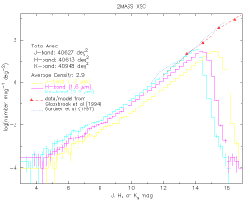
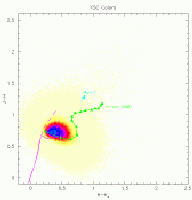
The 2MASS All-Sky Release covers >99% of the
sky (see II.3d1).
The Extended Source Catalog (XSC) contains
1.65 million sources which are resolved with respect to the
observed 2MASS point spread function. The Catalog sources were
selected to have the following properties:
Users are recommended to review the
Cautionary Notes for the XSC in Section
I.6.c for known features of and problems
in the Catalog.
Approximately 97% of XSC sources are galaxies, with the other ~3% belonging
to the Milky Way. The following subsections discuss
some of the basic properties of the XSC, with an image gallery to follow.
More information on the algorithms, derived
parameters, and the catalog/database, can be found in
IV.5.
Differential source counts (logN vs. logS) for the entire XSC
is shown in Figure 1. In
Figure 2 is shown the J-H vs.
H-Ks color-color Hess diagram for all XSC sources.
For reference, we also include the stellar main-sequence and evolved (giant)
tracks (green line), and the redshift K-correction (magenta line, assuming
SAB-type galaxies with no evolution cosmology; adapted from the models by
Bruzual & Charlot 1993, ApJ, 405, 538, and
McLeod & Rieke 1995, ApJ, 454, 611).
c. XSC Catalog Selection Criteria:
where two sets of photometry were used:
the source need only satisfy the SNR criteria in one or more bands;
d. General Properties
e. Photometric Properties
 |
 |
| Figure 1 | Figure 2 |
Extended sources range in size from 10´´ to nearly 2° in diameter
(e.g., M31; for the parameters of additional large galaxies, see Table 1
of Jarrett et al. 2003, AJ, 125, 525).
Most 2MASS XSC galaxies are small, settling near the resolution limit of 2MASS.
The distributions for extended sources of the isophotal and total radii are
shown in Figure 3 (galaxies) and
Figure 4 (Galactic sources).
f. Size Distribution
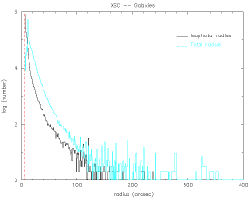 |
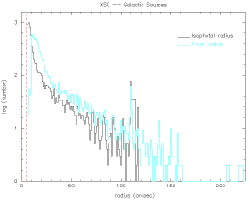 |
| Figure 3 | Figure 4 |
g. Relevant Images
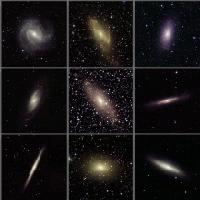 Figure 5:
The 30 Largest Galaxies in the Extended Source Catalog. Galaxies larger
than ~5´ were reconstructed using large
mosaics and source characterization optimized for large extended objects.
A description of the methods used to build the Large Galaxy Atlas and science
results using the Atlas is given in
Jarrett et al. (2003, AJ, 125, 525).
Figure 5:
The 30 Largest Galaxies in the Extended Source Catalog. Galaxies larger
than ~5´ were reconstructed using large
mosaics and source characterization optimized for large extended objects.
A description of the methods used to build the Large Galaxy Atlas and science
results using the Atlas is given in
Jarrett et al. (2003, AJ, 125, 525).
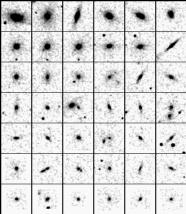 Figure 6:
Bright 2MASS galaxies as seen in the Ks-band.
The sequence is arranged in order of integrated Ks-band flux,
reading left to right. first panel: Ks magnitudes range from 9 to
10.5; second panel: 10.5 to 11.0; third panel: 11.0 to 11.6; fourth panel:
11.6 to 12.1;
fifth panel: 12.1 to 12.3; sixth panel: 12.3 to 12.6; last panel: 12.6 to 12.9.
Each image is 60´´ in angular width.
Figure 6:
Bright 2MASS galaxies as seen in the Ks-band.
The sequence is arranged in order of integrated Ks-band flux,
reading left to right. first panel: Ks magnitudes range from 9 to
10.5; second panel: 10.5 to 11.0; third panel: 11.0 to 11.6; fourth panel:
11.6 to 12.1;
fifth panel: 12.1 to 12.3; sixth panel: 12.3 to 12.6; last panel: 12.6 to 12.9.
Each image is 60´´ in angular width.
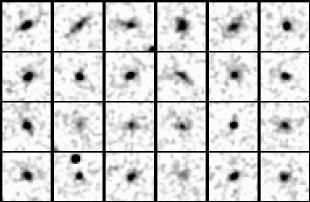 Figure 7:
2MASS galaxies at the Ks-band sensitivity requirement limit,
Ks~13.5 mag. The sequence is arranged in order of integrated
Ks-band flux, reading left to right. first panel: Ks magnitudes
range from 13 to 13.1; second panel: 13.1 to 13.3; third panel: 13.3 to 13.4;
last panel: 13.4 to 13.5. Each image is 30´´ in angular width.
Figure 7:
2MASS galaxies at the Ks-band sensitivity requirement limit,
Ks~13.5 mag. The sequence is arranged in order of integrated
Ks-band flux, reading left to right. first panel: Ks magnitudes
range from 13 to 13.1; second panel: 13.1 to 13.3; third panel: 13.3 to 13.4;
last panel: 13.4 to 13.5. Each image is 30´´ in angular width.

Figure 8:
Galaxies found in the Galactic Plane (approximate coordinates, in
decimal degrees: 240°, +4.5°), corresponding to a density of 4500
stars deg-2
brighter than Ks=14 mag. The sequence is arranged in order of
integrated Ks-band flux, ranging from 11.8 to 13.8 mag (reading left
to right). The upper row corresponds to the J-band postage stamp image; middle
row, the H-band; and, bottom row, the Ks-band images. Each image is
50´´ in angular width.

Figure 9:
Galaxies found near the Galactic Center bulge (approximate coordinates:
12°, +5.0°), corresponding to a density of 30,000 stars deg-2
brighter than Ks=14 mag. The sequence is arranged in order of
integrated Ks-band flux, ranging from 11.0 to 12.7 mag (reading left
to right). The upper row corresponds to the J-band postage stamp image; the
middle row, the H-band; and, the bottom row, the Ks-band images.
Each image is 50´´ in angular width.
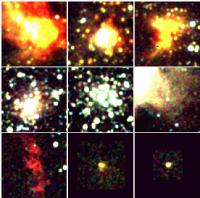 Figure 10:
Galactic extended sources. JHKs three-color images of
H II regions (upper panel), clusters and nebulosity (middle panel; far right
image corresponds to a piece of the Crab Nebula), reflection nebulae, and young
stellar objects (bottom panel).
Figure 10:
Galactic extended sources. JHKs three-color images of
H II regions (upper panel), clusters and nebulosity (middle panel; far right
image corresponds to a piece of the Crab Nebula), reflection nebulae, and young
stellar objects (bottom panel).
[Last Updated: 2003 Mar 13; by T. Jarrett and R. Cutri]
Previous page. Next page.
Return to Explanatory Supplement TOC Page.